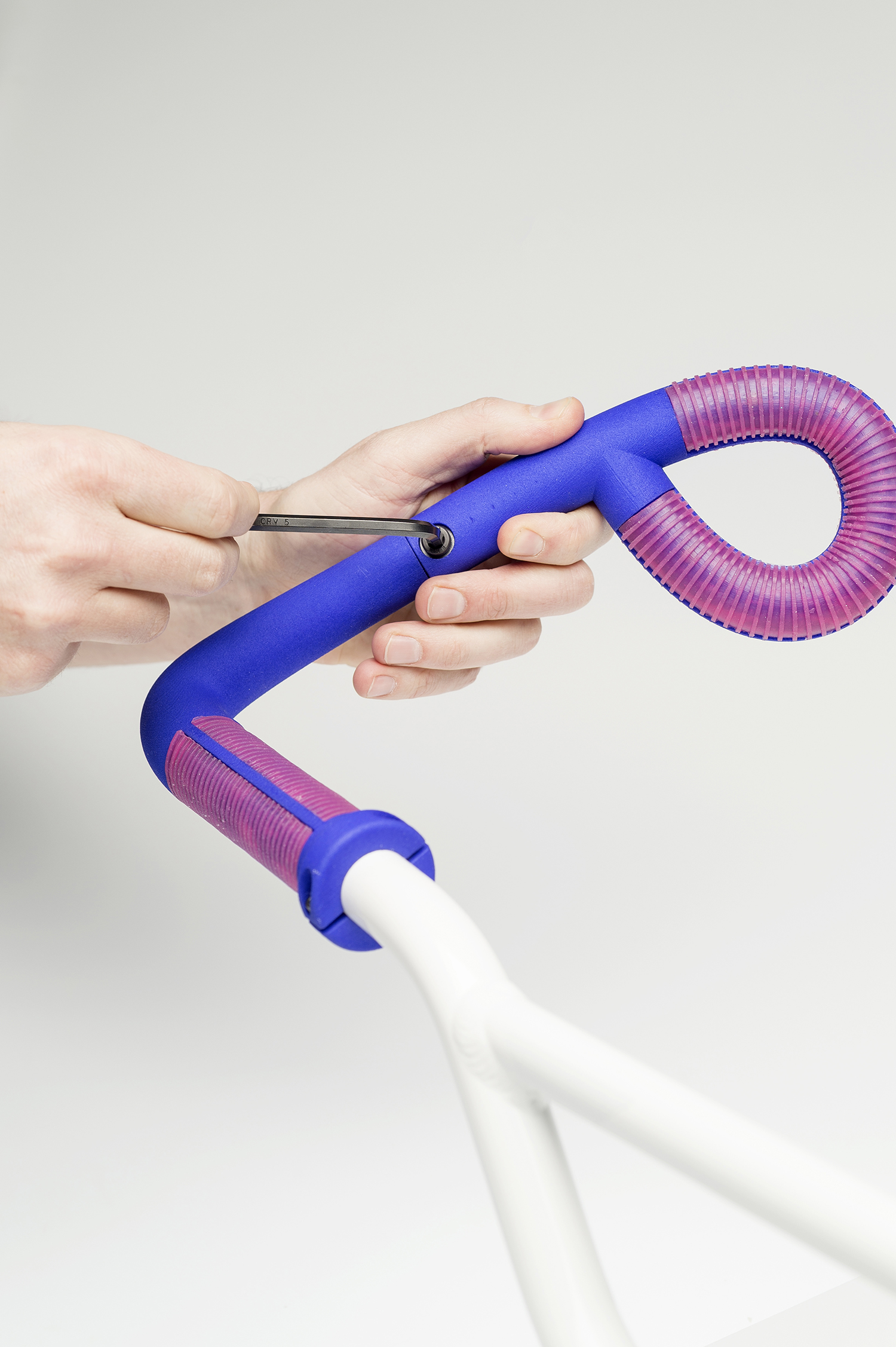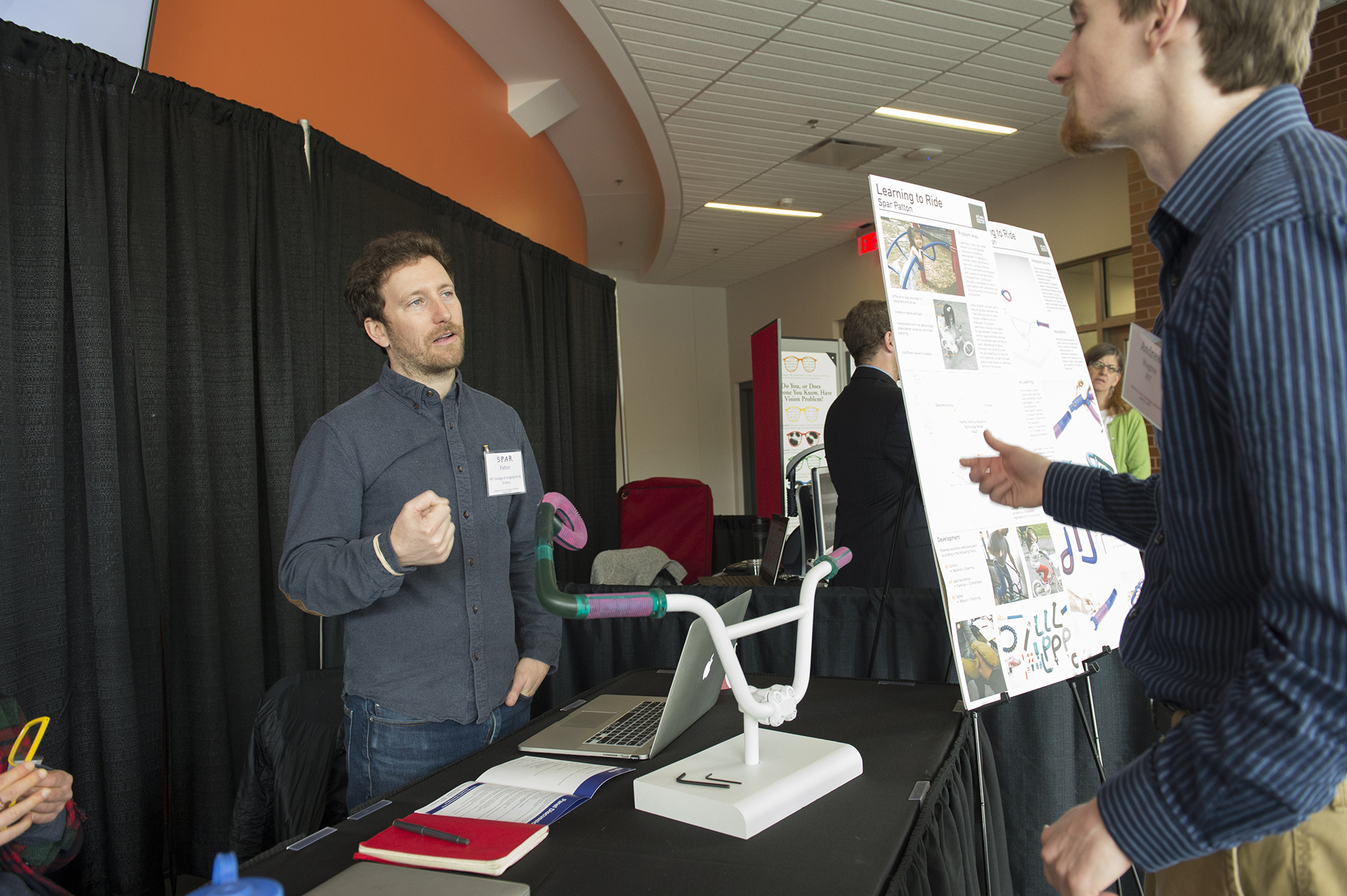ID student assists in 6-year-old’s quest to ride a bike
RIT Production Services
Spar Patton thinks every kid should experience the thrill of riding a two-wheel bike.
He’s been doing his part to ensure one young girl isn’t denied the sense of fulfillment that comes with learning to ride.
Patton, a graduating MFA industrial design student, constructed a customizable handlebar grip kit that makes operating a bicycle far easier than before for a motivated girl with a different range of motion in her right elbow, hand and fingers compared to kids of the same age. Patton’s bicycle cockpit tweaking was done specifically for 6-year-old Emily in an effort to make a substantial difference in her ability to balance and look ahead on a two-wheel bike.
Patton exhibited a prototype of the handlebar grips equipped for Emily at the Effective Access Technology Conference April 21 in the Gene Polisseni Center. The product, which brings key steering components closer to the bike user, is his thesis project. Patton decided to revolve all of his research and production around Emily, rather than it being more universal, and he’s worked with the young girl and her family since the fall.
Emily has what’s called ulnar club hand in her right forearm and hand. It’s characterized by the ulna (a long forearm bone) and other soft tissue structures on the ulnar side of the hand developing abnormally, leading to either instability in the wrist or elbow.
Emily’s right radial bone bows and she has two digits on her right hand. It causes her to position her body in different ways while riding a bike and grasp and balance using her armpit and pointer finger.
But Patton’s handlebar system is giving Emily a smoother, more efficient ride.
It features a standard straight grip on the left side. The right side consists of the same straight grip, with a connected elbow adapter that extends toward the body. A looped handle then screws into the adapter.
The structure brings the right handlebar directly to Emily’s right hand. It gives her increased control of the bike and prevents her from overreaching and risking instability. The system helps Emily’s steering, balance and leveraging of the pedals.
“She was having a lot of difficulty getting power to the pedals and also keeping her head up and being able to read terrain and consistencies,” Patton said. “So I basically worked with her with a number of different prototypes to figure out the ergonomics of where she wanted to make contact with the bike.”
It’s equipped for all bicycles, too, as the grips and associated parts are easily attached to and separated from frames.
“That’s kind of the idea — simple and fun,” Patton said. “Go ride a bike.”

Using Patton’s current model (pictured), Emily has ridden on training wheels the last month-plus while exhibiting elevated strength and muscle memory.
“Pretty soon (the training wheels) will come off,” Patton said. “She is determined to ride a two-wheel bicycle. … I think every kid should ride a bike, no matter what.”
Emily and Patton worked together to find the perfect design that addressed three areas in need of improvement and put less physical stress on Emily — control (balance and steering), approachability (familiarity and comfort) and safety (robust and forgiving).
The compatibility aspect of Patton’s innovation allows it to grow with Emily. Patton designed the grips to adjust as personal range and bike size changes. Like any other lock-on grips, these are suitable for any bike.
The colors are user's choice, too, with Emily deciding on a pink-and-purple color scheme.
“Every kid should be able to go into a bike shop and not have any special accommodations or have to go and see some special fabrication expert,” Patton said. “I think it should be an option that is just ready to go, like you would install any component on your bike.”
Patton sought to provide Emily with an all-encompassing bicycle experience. His consideration of all factors during the process of generating this assistive technology reflects that.
Patton’s research went beyond exploring just the functionality of the handlebar grips. What he came up with is something that is practical, travel-ready, sturdy and personally rewarding.
“How does it look when you’re riding with your friends?” Patton said. “What does that mean when your family goes on vacation and rents bikes? Can you do that? And with this, you can stick it in your luggage and bring it with you. … It’s definitely a lot of fun and I’ve been really lucky to work with her and her family.”
Patton set out to make a difference for Emily with this project and said he hasn’t given much thought to its wider marketability. While he noted that designing product details for one specific person does lend itself to widespread interest, he is still most concerned with this leading to Emily being able to cruise on two wheels.
“If it is (helpful) for her,” Patton said, “that’s all that matters.”









